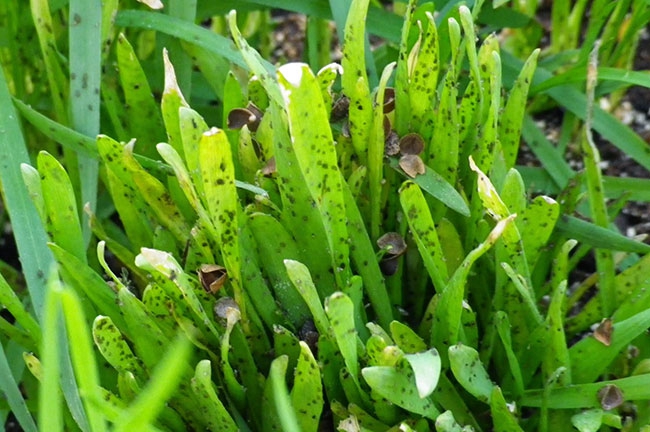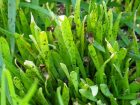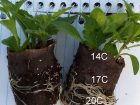
Features
Biocontrols
Inputs
Setting the Roots of a Good Biocontrol Program
I have mentioned and discussed before in Greenhouse Canada that biocontrol is a big part of Integrated PestManagement (IPM).
April 15, 2015 By Dr. Mohyuddin Mirza
 A closeup photo of oat banker plants.
A closeup photo of oat banker plants. May 2015 – The roots of this article started in March when I visited a bedding plant greenhouse. I am involved in an Integrated Pest Management (IPM) project funded by the Alberta Crops Industry Development Fund (ACIDF) and the Alberta Greenhouse Growers Association.
I was accompanied by scientist Dr. Kwesi Ampong Nyarko, from the Crop Diversification Centre North in Edmonton, and his technologist Olivia Hares. The intent was to see how growers are using IPM practices and biocontrol strategies.
I have mentioned and discussed before in Greenhouse Canada that biocontrol is a big part of IPM. Greenhouse vegetable growers throughout Canada adopted the use of biocontrols early, and bedding plant and ornamental growers are now not far behind.
I also want to point out that there is a trend in Alberta to import more unrooted cuttings. These cuttings can come from any part of the world and so growers are always concerned with any bugs getting to ride along.
Best efforts are always made to supply clean, bug-free material, but bugs have their own way to hide. Aphids are a prime example of insects that can hide in young and tender cuttings. In one greenhouse, two pots of barley banker plants had just arrived. The pots were surrounded with a fine mesh, so that the bird cherry oat aphids that were on those plants could not escape.
I could see several of these aphids gathering at the top left edge of the mesh surrounding the pots, as if they were desperate to leave their mesh cage.
The purpose of the banker plants is to establish sufficient numbers of these aphids. It’s important to note these aphids don’t attack common bedding plants.
Barley or oats are grown outside the cage. About eight to 10 plants are grown in a circle at the edge of the pot. Once these plants reach a height of six to eight inches, the plants loaded with bird cherry oat aphids are placed inside the circle.
Once the bird cherry oat aphids colonize the new plants, the grower releases the aphid parasitoid Aphidius colemani.Generally, 400-500 of these parasitoids are released. A. colemani is a parasitic wasp known to parasitize green peach aphid and melon aphid.
There are other parasitoids available for potato or foxglove aphids. Growers should develop their own expertise to recognize these aphids and seek help from the biocontrol agent suppliers so that they can target them.
It’s important to understand how banker plants are used and constantly monitor the type of aphids around them. These banker plants also need to be maintained properly. Feed them the same nutrients that you feed your plants.
GROWING USE OF DIPS WITH CUTTINGS
It appears that some “dips” are being used by growers with unrooted and rooted cuttings. One dip solution we saw consisted of Botanigard conidia, Root Shield and beneficial nematodes. The cuttings are dipped in this solution and then extra solution is strained off. All three products were from BioWorks Inc. There may be other products in the market place with similar properties.
One other unintended benefit of this dip was reported by the grower we visited. When some cuttings were dipped, they noticed some black flies were floating in the solution. The plants were moved to a quarantine area for closer observation. Having an area in the greenhouse where suspect plants can be isolated is a great idea.
The following useful information was found on the BioWorks website.
“Dips are simply the use of biopesticide solutions in a tray or tub where bundles of cuttings or trays of plugs can be briefly submerged and thoroughly wetted. Plant material is then stuck or planted. Many cuttings or trays can be quickly treated when dipped using lower volumes of pest control product.
“Effective dips can significantly reduce the need for heavy rounds of chemical pesticides later in the crop cycle and their resulting impact on biological control agents. The bottom line is that it saves money and time for growers. Several BioWorks products have been effectively used in dips:
- “BotaniGard® 22WP (do not use BotaniGard ES).
- “RootShield® WP.
- “RootShield® PLUS WP.
- “NemaShield™.
- “SuffOil-X® (Used at 0.1 per cent solution in Canadian study. Not labelled for dipping yet.)
I would like to point out that BotaniGard consists of spores (conidia) of a fungus that attacks whiteflies and thrips, while RootShield is another fungus that helps to reduce or control various root diseases. These fungi do require higher relative humidity to germinate and start the infection process and also proper temperature.
Unrooted cuttings go on to bottom heat and a misting system, so the above-mentioned fungal spores should establish themselves.
USE A HAND-HELD INFRARED THERMOMETER FOR ROOTZONE CHECK
If you are using drenches, then make sure there are proper temperature regimes. This is where a hand-held infrared thermometer is quite useful.
Look at the rootzone temperature photo at right. These plugs were pulled out of black plastic plug trays. The temperature at the top was 12-14 C, while in the middle it was 16-17 C, and at the bottom 20-21 C. So, if you have drenched these plugs with nematodes and the temperature is 14 C, then they may become “sluggish.” Also notice how most of the roots are where the temperature is the warmest!
Regular rootzone temperature monitoring and management will help produce a successful crop. I know more growers are paying attention to IPM and biological controls. More research and more products are coming into the marketplace. May is a very busy season for you.
Dr. Mohyuddin Mirza is an industry consultant. drmirzaconsultants@gmail.com
Print this page

